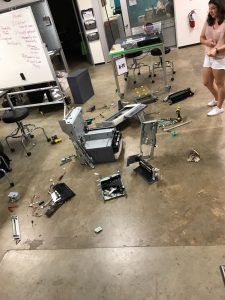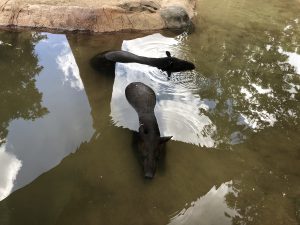After a few days of traveling and moving into my new dorm for the summer, I was ready to start SEED. As I was getting ready to sleep on the night before SEED began, it finally hit me that it was actually starting! I was excited and nervous because I wasn’t sure exactly what to expect from the internship. Was it exactly like ENGI 120? Was it more demanding? I just wasn’t sure.
All of my stresses and concerns were alleviated within the first few hours as we settled in with introductions and ice-breakers. I was surprised by the number of people in the internship, just 11 participants, but I could tell after a few hours that we were going to have a lot of fun this summer, although challenging. After the ice had been broken, we were introduced to the program and the program schedule. I did not know much information going in, so I was put at ease as the logistics and expectations became clearer.
After a few more safety and logistical presentations, we bonded and learned about each other a bit more. We competed for bragging rights in our skills at Super Smash Bros. and Mario Kart, a classic Rice pass-time. Even though our internship focuses on building and

The disassembled copy machine
completing design projects, we actually got to deconstruct two machines. In other words, we got to break apart an engine and a copy machine to see how the internal components worked together. Let me tell you, there were a lot of components. Although we didn’t really know how many of the electrical components worked, it was our first time working together on an engineering activity. We also highlighted the varying cultures that the SEED program brings together. Not only does the program include three students from Brasil, but the diversity among the Rice students is amazing as well. The presentations allowed us to acknowledge and learn about the diverse environment we will be working in.
We also went to the Houston Zoo (yes in the heat of the afternoon) for a scavenger hunt. Little did we know that our first trip was a prelude to our first engineering design project, which tasked us to design and build an enrichment device for the Tapir exhibit at the zoo. The device is meant to entertain the Tapir by evoking some natural behavior in them such as swimming, scratching, chewing, and foraging. It was an exciting project, but we had to wait another day to get started.
The next day, we returned to the Zoo and had the opportunity to interview the Tapir’s zookeeper. We had prepared questions ahead of time that would allow us to fully understand the Tapirs, their exhibit and behaviors, and the issues with enriching them. It certainly was a heated discussion, but thankfully only due to the blistering heat of the day and not hostility.
Once we understood the problem, we gathered all of the research and knowledge so that we were informed to make better decisions moving forward. Some of the topics we researched included past solutions to enriching Tapirs, regulations for Zoos and taking care of Tapirs, and even scientific background of possible materials we could use. This process went much quicker than I am accustomed to because we had the full internship working together gathering information.
We then went on to define our design criteria, or necessary attributes, goals, functions the device should have, based on the interview and research. We came up with 5 objectives: enrichment time, easy to clean, durability, natural looking, material cost. Also, we must ensure our device is safe to use for the Tapirs and Capybaras (an animal that shares the enclosure). Surprisingly, this process went very smoothly among my group, and we finished ahead of schedule.
At this point, we knew what criteria our device needed to meet, but we still needed to know how we were going to accomplish it, thus we began the process of brainstorming. Brainstorming allows us to engage in divergent thinking to come up with partial or complete solutions to the enrichment problem. This is probably one of my favorite steps in the Engineering Design process because we can have wild ideas and it is the first time we get to think about solutions. Each person in our four-person team came up with 20-30 solutions on their own, and then we proceeded to talk through each one and hitchhike off of each other’s ideas to create more innovative solutions. We even employed the use of a morphological chart, which describes the process of taking brainstormed partial solutions and combining them together to make whole solutions. We came up with about five more this way, but as we began to realize, there are infinite possibilities.
That is where we ended today, with hundreds of ideas, but no idea which one is the best. That will be a task for tomorrow, where we screen and score each solution to take our 100 ideas and reduce them to one or two ideas.

